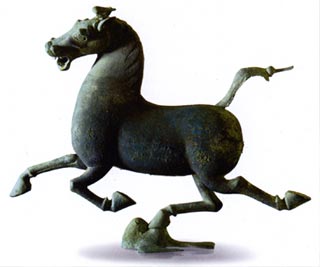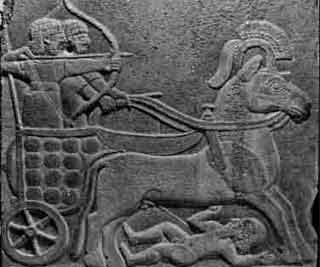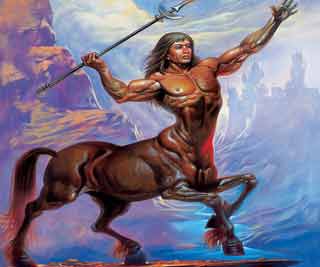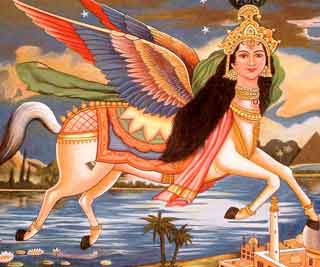The Year of the Horse
2014 is the Year of the Horse according to Chinese zodiac. The spirit of the horse is recognized to be the Chinese people’s ethos – making unremitting efforts to improve themselves. It is energetic, bright, warm-hearted, intelligent and able. Now let us talk about some stories about horse.Horse in Chinese History:The horse, which may have been domesticated in northeastern China around 5,000 years ago, was harnessed to chariots in the Shang Dynasty (1765-1123BC). During the Zhou Dynasty (1100-221BC), horses were generally divided into 6 categories: the stud horse, military horse, ceremonial horse, post horse, hunting horse and fatigue horse. A relatively complete horse management organization had been built up in the Qin and Han dynasties (221BC-AD220).About 300,000 horses were raised in the frontier northwestern regions in the Han Dynasty, and at the beginning of the Tang Dynasty (618-907) the number increased to over 700,000. More than 7,000 fine breeds of horses were introduced from remote western regions to improve the quality of military horses. Thriving horse breeding not only played an important role in national defense but also propelled cultural and economic communications between China and other nations in the West.By the beginning of the Ming Dynasty (1368-1644), the horse’s significance in transportation had been somewhat diminished by the further development of water-based shipping. Official horse breeding was greatly expanded in the Qing Dynasty (1644-1911), although non-governmental horse breeding was restricted and horse-trading was banned, which seriously damaged the industry.Due to warfare since the Revolution of 1911, especially during the War of Resistance against Japanese Aggression, horse breeding experienced a sharp decline. After the founding of the People’s Republic of China, the government took some protective measures in breeding domestic animals. As a result, the number of horses increased dramatically. As of 1977, the number of horses totaled 11,447,000, ranking No 1 in the world.Chinese genius produced one of the most significant inventions in equestrian history: an effective harnessing system based on the breast strap, the stirrup, and the horse collar. The harnessing system was the first to effectively utilize the horse’s power without hampering its breathing. It allowed for the development of shafted, horse-drawn vehicles far more advanced than their counterparts in the West. The invention of the stirrup was equally important; for the first time, mounted cavalrymen could sit stably while fighting.The image of the horse:Galloping Horse Treading on a Flying Swallow, or Bronze Galloping Horse, is a bronze artwork of the Eastern Han Dynasty (25-220). With a height of 34.5 cm and a length of 45 cm, the horse is raising its head, neighing and galloping forward with one hoof treading on a flying swallow, symbolizing that its speed can surpass that of the swallow.That the static sculpture is full of dynamic power reflects the excellent force of expression in ancient China’s bronze artwork. The positioning of its 4 legs strictly conforms to that of a living horse with the barycenter on a little swallow, manifesting the high level of design and craftsmanship. It is also fully expressive of the horse-breeding culture of ancient China.

The Six Steeds of the Zhaoling Mausoleum holds six stone relief sculptures that were located on the northern slope of the Zhaoling Mausoleum in Shaanxi, where Emperor Taizong, the first emperor of the Tang Dynasty was buried. The 6 steeds were 6 precious warhorses of Taizong, on which he fought the battles for the foundation of Tang.Carved on 6 slates that are 2.5 meters high and 3 meters wide, the 6 steeds were in high relief, vividly exhibiting their posture and character by a few compact lines and accurate sculpting. They told soul-stirring stories of galloping on the battlefields with arrows piercing their bodies.

The Five Horses is a masterpiece by Li Gonglin, an influential painter of the Song Dynasty. The 5 rare horses were introduced from the West to the Central Plains. They had coats of different shades and colors, and distinct features. The horses are accompanied by 5 grooms garbed in their national costumes.Its style is characterized by a highly subtle and brief application of the brush and ink. The horses, with their lithe, tough, smooth, masculine bodies in a gentle posture appear gallant and dignified. The perfect lines and modeling by Li Gonglin fully demonstrate the high level that “Baimiao” (plain drawing) had reached in Chinese painting.

The legend of the horse:A legend from more than 2,000 years ago tells of a mysterious “blood-sweating” horse (“heavenly horses”) that was raised in Ferghana in Central Asia. The horse was known for its speed, endurance and perspiration of a blood-like fluid as it galloped along. Zhang Qian, an imperial envoy to the Western Regions, first told Emperor Wu of Han about them. The Emperor then sent an envoy to ask for the fine horses, but Ferghana refused and killed the envoy. Whereupon, Emperor Wu waged a war against Ferghana. In the 4th consecutive year of the campaign, Ferghana presented the Chinese with 30,000 horses. It was also believed to be the horse ridden by Genghis Khan.In the classic novel “Romance of the Three Kingdoms,” when Liu Bei sought refuge with Liu Biao in Jingzhou, the horse he rode was called Dilu. Others told him that there was a tear notch under its eyes with white spots on its forehead, a sign that it would harm its owner. Liu Bei was not afraid and continued to ride the horse.Once, Liu Biao’s wife, Lady Cai, and her brother, Cai Mao, gave a banquet with the aim of harming Liu Bei. When Liu Bei detected the intention, he escaped on Dilu, and was chased by the enemy to the Tan Stream. He attempted to ride across the stream, but Dilu fell forward in the water. Liu Bei whipped the horse and exclaimed, “Dilu! Dilu! Today you obstruct me!” Dilu suddenly rose above the surface and leapt 3 zhang (10 meters) across the stream to the opposite bank, leaving the enemies behind and saving Liu Bei.The White Dragon Horse is one of the main characters in the classic novel “Journey to the West.” He is actually the 3rd son of a Dragon King of the West Sea. He once set a fire that destroyed a pearl that was a gift from the Jade Emperor. To redeem him from his sins, Boddhisatva Guan Yin gracefully allows him to serve as a mount for the monk Xuanzang during his mission to fetch scriptures from “the West.” Throughout the novel, the dragon-horse serves a role of quiet loyalty and mindful willpower. Horses and the western civilizationThe horse plays an important role in the evolution and development of Western civilization; it is representative of freedom, power and grace.Horses and war:The Hittites invented the war chariot and conquered Mesopotamia and Egypt around 1800 BC as a result. The swift-moving chariots held two men, one to drive and one to fight.

The appearance of these unfamiliar animals and the speed at which chariot-borne spearmen and bowmen could deliver their deadly blows must have been as terrifying to Bronze Age footsoldiers as the thought of the hydrogen bomb is to us today.Individual mounted soldiers do not appear in historical records until some 800 years later, around 1000 BC.Horses and communication:Until the steam engine and the telegraph appeared in the 19th Century, there was no match for the horse for swift travel and communications. The Persians in the 5th century BC, who built the largest empire of their time, dispatched commands from their capital using relays of mounted couriers.Horses and entertainment:Persians and Greeks staged horse races and both seem to have been the earliest people to take an active interest in horsemanship as a discipline.The Art of Horsemanship, a treatise by the Greek historian and philosopher Xenophon, who lived from 430 to 354 BC, is the oldest surviving text of its kind in the world, and much of his advice is followed by horsemen today.Horse in myth: A half man, half horse is called a centaur. Imagine a horse except that for the head, you replace it with a man from his head to the waist. According to the Greek legends, they were said to be the offspring of Ixion, king of the Lapiths. The Zodiac sign Saggittarius is represented by a centaur with a bow and arrow.

Al-Buraq (meaning “the lightning”) is a horse with the head of a woman and the wings of an eagle. The most commonly told story is how in the 7th Century, Al-Buraq carried the Islamic prophet Muhammad from Mecca to Jerusalem and back during the “Night Journey.”

The Four Horsemen of the Apocalypse are described in the New Testament’s Book of Revelation. The four riders on white, red, black, and pale horses symbolize pestilence, war, famine, and death, respectively, who will usher in the end of the world, the second coming of the Christ and the vanquishing of all evil.Not all horses, however, have been portrayed as noble and good:Scottish and Irish tales tell of the Each Uisqe, a supernatural water horse that feeds on human flesh.In the Philippines, the Tikbalang, usually with the head and feet of a horse, is said to lead travelers astray, getting them utterly lost in the remote forests of the mountains.The symbolism of horse:An important thing to remember about horses is that they are representative of freedom. The horse serves man, but can never be fully tamed by him. The horse is a universal symbol of freedom without restraint, because riding a horse made people feel they could free themselves from their own bindings.The horse also represents power in Native American tribes. Native American tribes that possessed horses often won more battles than those who did not. They also had more territory. The number of horses a tribe possessed was telling of how wealthy they were.The horse also symbolizes grace. For sheer nobility, there is no breed on earth that can touch the Arabian, the aristocrat of aristocrats.In some cultures, the white horse symbolizes light, sun, day vitality, illumination, resurrection, and is a messenger of birth. In others, like Christianity, the white horse is a symbol of death. It can also represent fertility.A dark horse (not “black horse”) is a little-known person or thing that emerges to prominence, especially in a competition of some sort. The earliest-known mention of the concept is in former British prime minister Benjamin Disraeli’s novel “The Young Duke” (1831). Disraeli’s protagonist, the Duke of St James, attends a horse race with a surprise finish: A dark horse which had never been thought of rushed past the grandstand in sweeping triumph. *The above information is abstracts from ChinaDaily Jornen Machinery Co., Ltd. 02-02-2014
